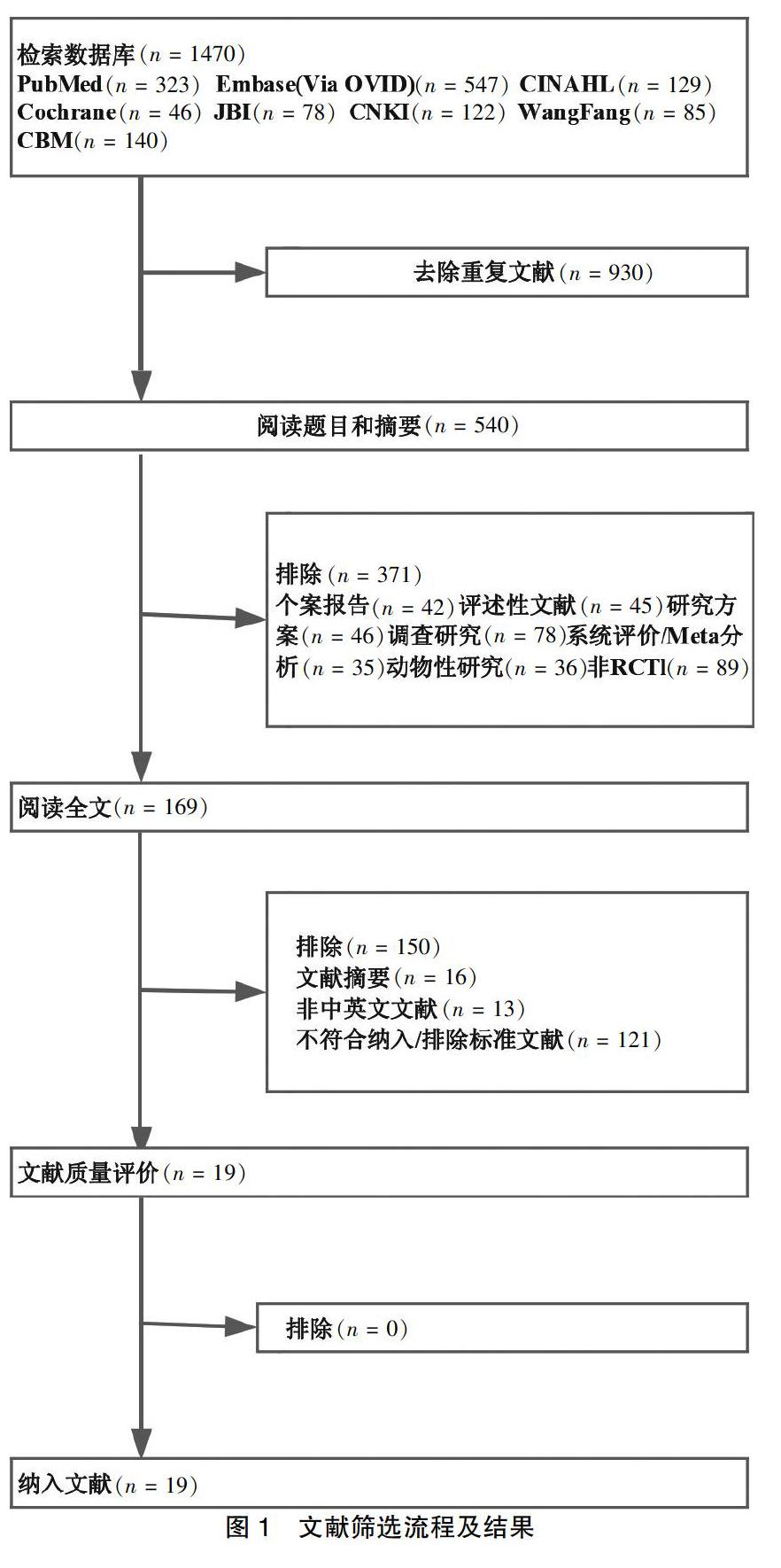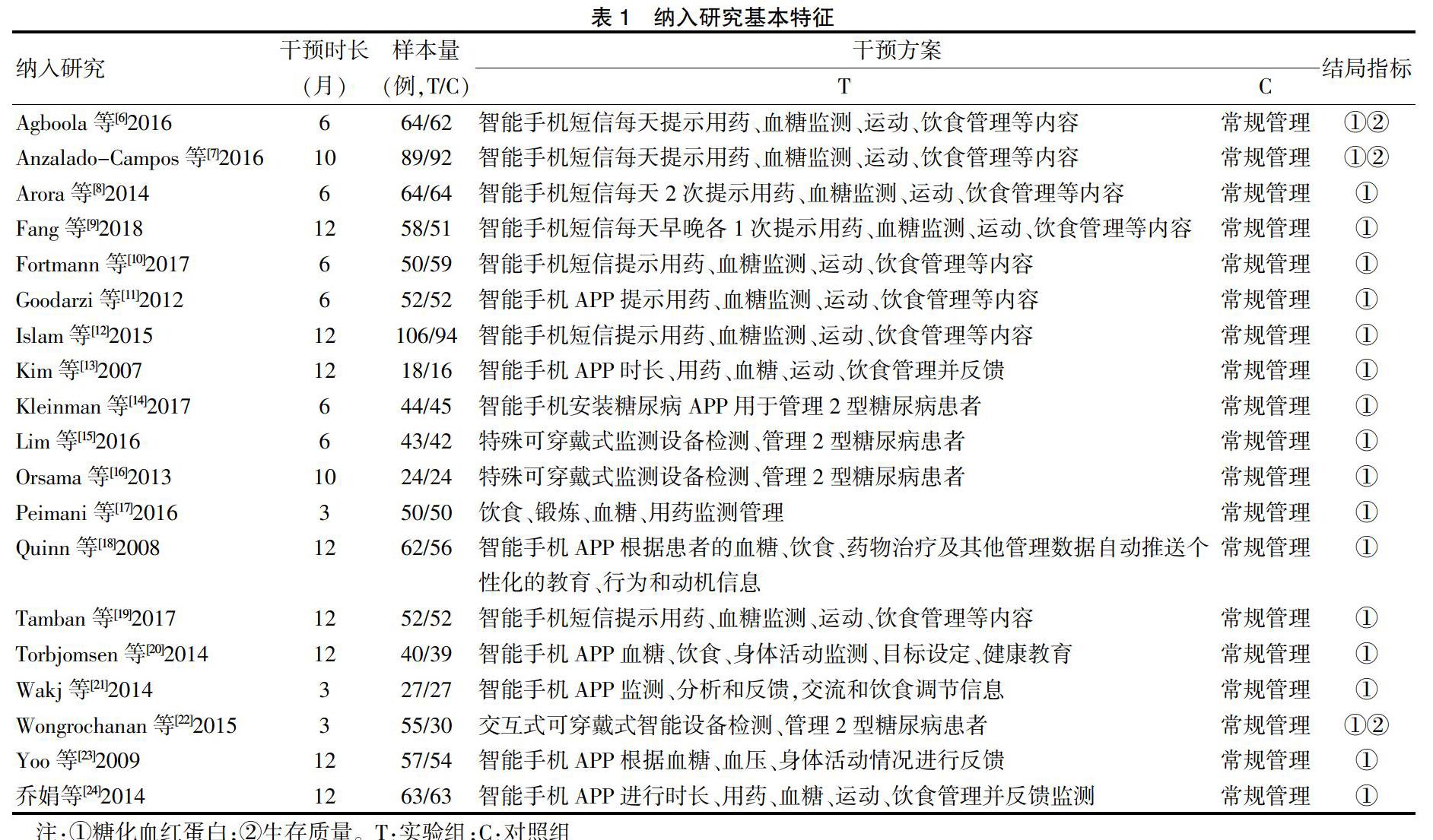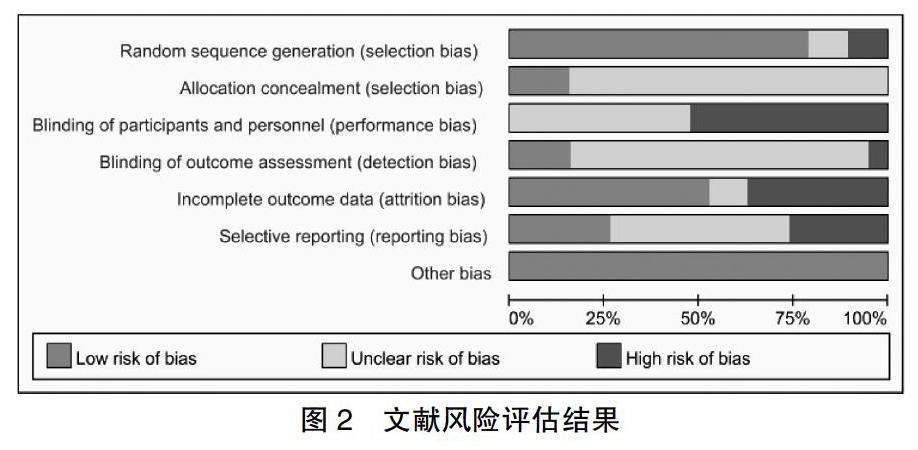黄厚强 郭声敏 陈佩云



[摘要] 目的 系统评价应用智能手机对2型糖尿病患者管理的效果。 方法 检索PubMed、Cochrane、CINAL、JBI、Embase、CBM、CNKI、万方数据库、维普数据库中应用智能手机对2型糖尿病患者血糖影响的随机对照研究,检索时限为建库至2019年11月15日。通过文献筛查、文献质量评价,应用RevMan 5.3软件进行数据整合。 结果 共纳入19篇文献,2376例患者。试验组糖化血红蛋白明显低于对照组[MD(95%CI):-0.54(-0.68,-0.40)],患者生存质量明显高于对照组[MD(95%CI):0.26(0.06,0.47)],差异有统计学意义(P < 0.05)。亚组结果显示:干预时长3个月,两组患者糖化血红蛋白比较,差异无统计学意义(P > 0.05);试验组干预6个月[MD(95%CI):-0.42(-0.63,-0.22)]及10~12个月[MD(95%CI):-0.63(-0.85,-0.41)]糖化血红蛋白低于对照组,差异有统计学意义(P < 0.05)。 结论 应用智能手机对2型糖尿病患者血糖进行自我管理能改善患者血糖控制效果,提升患者生活质量。
[关键词] 智能手机;2型糖尿病;慢病管理;系统评价
[中图分类号] R318 [文献标识码] A [文章编号] 1673-7210(2020)08(b)-0154-07
[Abstract] Objective To systematic evaluate the effect of using smart phones on the management of patients with type 2 diabetes. Methods PubMed, Cochrane, CINAL, JBI, Embase, CBM, CNKI, Wanfang database, VIP database for randomized controlled studies were searched on the effect of smartphones on blood glucose in patients with type 2 diabetes, and the search time limit was from the construction of the database to November 15, 2019. Through literature screening and literature quality evaluation, RevMan 5.3 software was used for data integration. Results A total of 19 articles and 2376 patients were included. Glycated hemoglobin in the test group was significantly lower than that in the control group (MD[95%CI]:-0.54[-0.68,-0.40]), while the patient′s quality of life was significantly higher than the control group(MD[95%CI]:0.26[0.06,0.47]), and the differences were statistically significant (P < 0.05). The results of the subgroups showed that the after three months of intervention, and the difference between the two groups of glycosylated hemoglobin was not statistically significant (P > 0.05); the glycosylated hemoglobin of experimental group after intervention for six months (MD[95%CI]:-0.42[-0.63,-0.22]) and 10 to 12 months (MD[95%CI]:-0.63[-0.85,-0.41]) were lower than those of the control group, and the differences were statistically significant (P < 0.05). Conclusion The smartphone-based management for patients with type 2 diabetes can improve the management effect of glycosylated hemoglobin and the quality of life.
[Key words] Smartphone; Type 2 diabetic patients; Chronic disease management; Meta-analysis
2型糖尿病是以胰岛素抵抗和β细胞受损为特征的一种慢性疾病,可导致心脏病、卒中等其他疾病发生[1]。据2014年WHO报告显示[2],全世界糖尿病患者约4.22亿人,其中2型糖尿病占比高达90%。2型糖尿病的治疗关键是有效控制糖化血红蛋白含量。研究显示[3],良好的自我管理可改善糖尿病患者的健康结局指标。近年来,随着移动互联网的普及,手机作为智能终端应用于2型糖尿病患者自我管理受到更多重视,但目前的相关研究存在样本量较小、研究结论不统一等问题。因此,本研究旨在通过系统评价的方式评价智能手机终端对2型糖尿病患者管理的影响,以期为临床开展2型糖尿病血糖管理提供证据。
1 资料与方法
1.1 纳入及排除标准
纳入标准:①文献类型:随机对照试验;②研究对象:诊断为2型糖尿病;③干预措施:试验组采用智能手机App或短信干预,对照组采用常规干预或空白对照;④结局指标:糖化血红蛋白、生活质量。
排除标准:①结局指标数据不完整;②评价为C的低质量研究。
1.2 文献检索策略及数据提取
检索各电子数据库公开发表的中英文文献,检索时限为各数据库自建库至2019年11月15日。中文数据库中以“手机”“智能手机”“电话”“糖尿病”“2型糖尿病”为关键词,分别在中国期刊全文数据库(CNKI)、万方数据库和维普数据库(VIP)、中国生物医学文献数据库(CBM)中进行检索。英文以“Mobile Phone”“Cell Phone”“Smart Phone”“phone”“Microphone”“Type 2 Diabetes”“T2DM”“Diabetes”在PubMed、Cochrane、CINAL、JBI、Embase中检索。研究者依照统一的数据提取表格对纳入的研究资料进行提取,包括作者姓名、干预时长、样本量大小、干预内容、研究结局指标。
1.3 文献质量评价
采用Cochrane协作网RCT质量评价方法[4-5]。2名研究人员各自独立的完成文献质量评价后,再对每篇文献进行讨论。有争议的条目取得一致共识后,形成最终结果,若存在分歧且无法取得共识,咨询第3名研究人员。
1.4 统计学方法
采用RevMan 5.3软件对所得数据进行统计分析。计量资料采用均数差(MD)及95%CI描述。通过χ2检验确定是否存在异质性,采用漏斗图评估研究的发表偏倚。以P < 0.05为差异有统计学意义。
2 结果
2.1 文献筛查结果
初检出文献1470篇,去除重复文献后,共540篇。阅读题目与摘要后排除371篇;进一步阅读全文,排除研究对象、干预措施、结局指标等不符合研究,最终纳入19篇文献[6-24],共2376例患者。见图1。
2.2 纳入研究基本特征
共纳入19篇文献[6-24],其中18篇英文文献[6-23],1篇中文文献[24]。纳入文献均报告干预时长,试验组采用智能手机下载相关糖尿病管理APP或采用智能手机发送短信进行干预,对照组采用常规管理。所有纳入文献将糖化血红蛋白含量作为主要的结局指标,生存质量评价在不同研究中的评价工具不同。见表1。
2.3 文献质量评价
19篇研究[6-24]质量评价为B级,提示纳入研究的总体质量尚可。见图2~3。
2.4 Meta分析结果
2.4.1 两组患者糖化血红蛋白meta分析
对纳入的19篇[6-24]文献进行糖化血红蛋白meta整合,异质性检验结果I2 = 35%。两组患者糖化血红蛋白比较,差异有统计学意义[MD(95%CI):-0.54(-0.68,-0.40),P < 0.05]。见图4。
2.4.2 亚组分析-糖化血红蛋白
由于纳入本研究的文献干预时长不完全相同,因此依据干预时长对两组患者糖化血红蛋白进行亚组分析。
2.4.2.1 干预3个月 共纳入3篇[17,21-22]文献,异质性检验显示I2 = 0%。两组患者糖化血红蛋白比较,差异无统计学意义[MD(95%CI):-0.43(-0.74,-0.11),P > 0.05]。见图5。
2.4.2.2 干预6个月 共纳入6篇[6,8,10-11,14-15]文献,异质性检验显示I2 = 0%。两组患者糖化血红蛋白比较,差异有统计学意义[MD(95%CI):-0.42(-0.63,-0.22),P < 0.05]。见图6。
2.4.2.3 干预10~12个月 共纳入10篇[7,9,12-13,16,18-20,23-24]文献,异质性检验显示I2 = 55%。两组患者糖化血红蛋白比较,差异有统计学意义[MD(95%CI):-0.63(-0.85,-0.41),P < 0.05]。见图7。考虑结果存在中度异质性(I2 = 55%),因此逐一去除纳入研究敏感性分析,结果与初始合并效应方向相同,干预后试验组糖化血红蛋白量低于对照组,差异有统计学意义(P < 0.05)。
2.4.2 两组患者生存质量meta分析
共纳入3篇[7-8,22]文献,异质性检验结果显示I2 = 0%。试验组生存质量高于对照组,差异有统计学意义[MD(95%CI):0.26(0.06,0.47),P < 0.05]。见图8。
2.5 纳入研究发表偏倚评价
采用漏斗图评估发表偏倚,发现存在明显不对称分布,存在发表偏倚。见图9。
3 讨论
3.1 纳入研究质量
纳入19篇[6-24]文献质量评价皆为B级。在纳入文献中15篇[6-11,13-17,19-21,24]详细描述了随机分组方法;3篇[6,14,19]文献介绍了研究的分配隐藏方法及盲法的使用,10篇[6-7,10,14,17,19-21,23-24]文献介绍了病例的退出、失访及在数据分析中采用的统计学处理方法。纳入研究整体尚可,但依然存在随机方法、分配隐藏、盲法未详细描述的问题。
3.2 Meta分析结果
3.2.1 糖化血红蛋白
2型糖尿病管理的主要目标是控制糖化血红蛋白含量,相关研究显示自我管理对2型糖尿病血糖管理有效[25-27]。在我国由于现代生活节奏加快,2型糖尿病血糖控制效果往往不尽人意。截至2019年6月,中国网民规模达8.54亿人,手机上网比例超过98.3%[28],因此研究应用手机对2型糖尿病血糖管理具有十分重要的意义。
本研究发现应用智能手机对患者进行血糖管理相较于常规管理方式而言,能够提升2型糖尿病患者血糖管理水平,降低糖化血红蛋白含量。分析原因,考虑应用智能手机对2型糖尿病进行管理,各个研究的管理内容均为饮食、锻炼、血糖、用药监测等内容,管理内容具有针对性;其次基于智能手机平台规律的督促、指导患者,显着加强了2型糖尿病患者的依从性[29-30];另外智能手机平台实时将患者问题汇报给医护人员能够更加方便快捷的处理问题,提高了患者对自身健康状况的重视程度,促使其建立良好的生活方式。本研究考虑干预时长差异可能对研究结果有影响对其进行了亚组分析,结果显示,干预3、6、10~12个月均能有效降低血糖含量。这可能是由于纳入的研究中均含有监测、反馈、互动功能有关,可以及时的处理发现的问题;研究认为监测、反馈调节是自我管理中最核心的内容[31-32]。但目前的研究皆从结果层面进行讨论,没有相关的理论作为血糖改善的依据;同时,纳入本研究的相关文献干预内容表现形式存在部分临床异质性如短信或APP,没有统一、标准的干预方式及内容,期待以后的研究中能够进一步明确。
3.2.2 生存质量
生存质量是个体生理、心理、社会功能3个方面的状态评估。本研究显示,试验组患者生存质量高于对照组,差异有统计学意义(P < 0.05)。可能是由于生存质量与自我管理高度相关,智能手机干预显着提升2型糖尿病患者依从性,提高自我管理能力以此增强患者自我效能,又显着提高患者自信。因此,患者焦虑、抑郁情绪得到控制,生存质量得到提高[33]。
4 结论
综上,现有证据支持使用智能手机对2型糖尿病患者进行自我管理能够降低血糖水平,提升患者生存质量。
[参考文献]
[1] Barry M,Brenner,Mark E,et al. Effects of Losartan on Renal and Cardiovascular Outcomes in Patients with Type 2 Diabetes and Nephropathy [J]. N Engl J Med,2001,345(12):861-869.
[2] World Health Organization,2016. Global Report on Diabetes. http://apps.who.int/iris/bitstream/handle/.
[3] Shrivastava SR,Shrivastava PS,Ramasamy J. Role of self- care in management of diabetes mellitus [J]. J Diabetes Metab Disord,2013,12(1):11-15.
[4] 徐俊峰,安妮,周为文,等.《中国循证医学杂志》发表的干预类系统评价/Meta分析方法学质量评价[J].中国循证医学杂志,2013,13(5):605-611.
[5] Higgins JPT,Altman DG,Gotzsche PC,et al. The Cochrane Collaboration′s tool for assessing risk of bias in randomized trials [J]. BMJ,2011,343(2):d5928-d5928.
[6] Agboola S,Jethwani K,Lopez L,et al. Text to Move:A Randomized Controlled Trial of a Text-Messaging Program to Improve Physical Activity Behaviors in Patients With Type 2 Diabetes Mellitus [J]. J Med Internet Res,2016,18(11):e307.
[7] Anzaldo-Campos MC,Contreras S,Vargas-Ojeda A,et al. Dulce Wireless Tijuana:A Randomized Control Trial Evaluating the Impact of Project Dulce and Short-Term Mobile Technology on Glycemic Control in a Family Medicine Clinic in Northern Mexico [J]. Diabetes Technol Ther,2016,18(4):240-251.
[8] Arora S,Peters AL,Burner E,et al. Trial to Examine Text Message-Based mHealth in Emergency Department Patients With Diabetes(TExT-MED):A Randomized Controlled Trial [J]. Ann Emerg Mede,2014,63(6):745-754.
[9] Fang R,Deng X. Electronic messaging intervention for management of cardiovascular risk factors in type 2 diabetes mellitus:A randomised controlled trial [J]. J Clin Nurs,2018,27(3/4):612-620.
[10] Fortmann AL,Gallo LC,Garcia MI,et al. Dulce Digital:an mHealth SMS-based intervention improves glycemic control in Hispanics with type 2 diabetes [J]. Diabetes Care,2017,40(10):1349-1355.
[11] Goodarzi M,Ebrahimzadeh I,Rabi A,et al. Impact of distance education via mobile phone text messaging on knowledge,attitude,practice and self efficacy of patients with type 2 diabetes mellitus in Iran [J]. J Diabetes,2012, 11(1):10.
[12] Islam SMS,Niessen LW,Ferrari U,et al. Effects of mobile phone SMS to improve glycemic control among patients with type 2 diabetes in Bangladesh:a prospective,parallel-group,randomized controlled trial [J]. Diabetes Care,2015,38(8):112-113.
[13] Kim HS. A randomized controlled trial of a nurse short-message service by cellular phone for people with diabetes [J]. Int J Nurs Stud,2007,44(5):687-692.
[14] Kleinman NJ,Shah A,Shah S,et al. Improved medication adherence and frequency of blood glucose self-testing using an health platform versus usual care in a multisite randomized clinical trial among people with type 2 diabetes in India [J]. Telemed JE Health,2017,23(9):733-740.
[15] Lim S,Kang SM,Kim KM,et al. Multifactorial intervention in diabetes care using real time monitoring and tailored feedback in type 2 diabetes [J]. Acta Diabetol,2016, 53(2):189-198.
[16] Orsama AL,Lhteenmki J,Harno K,et al. Active Assistance Technology Reduces Glycosylated Hemoglobin and Weight in Individuals With Type 2 Diabetes:Results of a Theory-Based Randomized Trial [J]. Diabetes Technol Ther,2013,15(8):662-669.
[17] Peimani M,Rambod C,Omidvar M,et al. Effectiveness of short message service-based intervention(SMS)on self-care in type 2 diabetes:A feasibility study [J]. Prim Care Diabetes,2016,10(4):251-258.
[18] Quinn CC,Clough SS,Minor JM,et al. WellDoc mobile diabetes management randomized controlled trial:change in clinical and behavioral outcomes and patient and physician satisfaction [J]. Diabetes Technol Ther,2008, 10(3):160-168.
[19] Tamban C,Isip-Tan IT,Jimeno C. Use of short message services(sms)for the management of type 2 diabetes mellitus: a randomized controlled trial [J]. JAFES,2017, 28(2):143.
[20] Torbjrnsen A,Jenum AK,Smstuen MC,et al. A Low-Intensity Mobile Health Intervention With and Without Health Counseling for Persons With Type 2 Diabetes,Part 1:Baseline and Short-Term Results From a Randomized Controlled Trial in the Norwegian Part of Renewing Health [J]. JMIR Mhealth Uhealth,2014,11:2(4):e52.
[21] Waki K,Fujita H,Uchimura Y,et al. DialBetics:a novel smartphone-based self-management support system for type 2 diabetes patients [J]. J Diabetes Sci,2016,8(2):209-215.
[22] Wongrochananan S,Tuicomepee A,Buranarach M,et al. The effectiveness of interactive multi-modality intervention on self-management support of type 2 diabetic patients in Thailand:a cluster-randomized controlled trial [J]. Int J Diabetes Dev Ctries,2015,35(2):230-236.
[23] Yoo HJ,Park MS,Kim TN,et al. A ubiquitous chronic disease care system using cellular phones and the internet [J]. Diabetes Med,2009,26(6),628-635.
[24] 乔娟,郝彦斐,燕增奎.基于智能手机的青中年2型糖尿病患者健康管理的效果观察[J].医疗卫生装备,2014,35(12):89-91.
[25] 孙晓敏,汪虹,许方蕾,等.个性化健康教育对2型糖尿病患者自我管理行为及血糖控制效果的影响[J].中国护理管理,2015,15(2):179-182.
[26] 高希震,蒋丹玛,陈碧华,等.基于网络的远程医疗在家庭病床2型糖尿病患者综合管理中的应用概述[J].中外医学研究,2018,16(15):174-176.
[27] 荣蓉,孙斐.电子信息化在糖尿病患者规范使用胰岛素中的应用[J].现代医院,2018,18(2):237-239.
[28] CNNIC互联网研究.第43次CNNIC中国互联网报告发布[J].中国广播,2019(4):48.
[29] 乔娟,郝彦斐,燕增奎.基于智能手机的青中年2型糖尿病患者健康管理的效果观察[J].医疗卫生装备,2014(12):89-91.
[30] 姚林华,温晓红,王菲菲,等.微信联合常规治疗对糖尿病患者幽门螺杆菌根除效果及血糖控制的影响[J].中国现代医生,2019,57(20):112-115.
[31] 梁柳桢,闵珊,罗敏娟,等.互联网结合中医特色慢病管理对2型糖尿病患者血糖的影响[J].中国医药科学,2020,10(2):187-190.
[32] 李莹,谭进,钟代笛,等.中国糖尿病自主管理应用程序现状分析[J].北京生物医学工程,2016,35(3):283-289.
[33] Jonkman NH,Schuurmans MJ,Groenwold RHH,et al. Identifying components of self-management interventions that improve health-related quality of life in chronically ill patients:systematic review and meta-regression analysis [J]. Patient Educ Couns,2016,99(7):1087-1098.
(收稿日期:2019-12-13)



